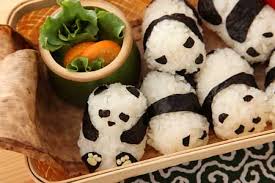Rice Cooking
The rice for the rice balls is cooked like a normal rice but unlike rice for sushi it is not acidified after the cooking. However take care to use round grain rice and avoid cooking bags. Long-grain rice and rice in cooking bags is extra loose after the cooking and thus it is not usable for onigiri. For onigiri, you need a rice, which is tacky by nature.
We recomend round grain rice:
1kg round grain rice for Onigiri
- First wash the rice. Add a little water to the rice and move the pot back and forth. Then pour off the water. The remaining water must be carefully sqeezed out, repeat until the water remains clean.
At first the water will be a little white from the bran. Wash the rice until the water remains clear.
- Add now the same amount of cups, as you used the for rice, of water in a pot and add a small extra sip (10%).
- Seal the pot with the lid and boil the rice for 8 minutes at high heat (level 3 or 12, depending on the type of stove), always leave the pot covered.
- Then turn down the heat to level 1 and simmer another 7 minutes, however without opening the lid.
- Turn off the stove and leave the rice in the pot for another 5 minutes.
- Finally dunk the bottom of the closed pot in cold water, so that the rice can detach from the inside of the pot.
Salt / Saltwater
Rice for onigiri is not acidified with sushi vinegar like sushi rice, but is processed unseasoned or salted. If you have enough practise, you know how much salt you must spread on the palms, before you roll the onigiri. But as salt is a rather disagreeable condiments (to “desalinate” is not possible) we recomend to fill a small bowl with water and then add ca.10% salt. Stir briefly and you can use the water to moisten your hands, before you start to roll the onigiri.
Store Onigiri
Onigiri should be eaten within one day after preparation. Try to avoid storing onigiri in a refrigerator for too long, as this will turn the rice hard and bad-tasting. Wrap to the onigiri therefore firmly with cling film, before you put them in the fridge. It will delay the curing.
Should you make onigiri with Nori (seaweed flakes), wrap the seaweed around the onigiri shortly before eating, as the Nori, as soon as it comes in contact with the moisture of the rice, begins to get rubbery.
Best you take the onigiri with you in a Bento box, where you have multiple partitions, to separate the different components.
There are three basic types of Onigiri or Omusubi. The most common is the triangular Onigiri, but there are also round and cylindrical onigiri.
Of course it`s up to you which type of Onigiri you prefer. But choosing different shapes and decorations leads to the most beautiful and funniest compilations. These are no limits to your imagination. In Japan, one often finds onigiri that have faces to look like animals, that are elaborately decorated or are colorful figures of the fables.
Sankaku Onigiri (triangular)
The triangular onigiri are the most popular form of onigiri.
First: moisten your hands!
Should the onigiri easily fall apart your hands or the rice were too moist.
Form with your right hand the lower edge and with your left hand the tip. Then press the onigiri into your left hand, while you squeeze the top with your right hand. Finally, you smooth the sides of the rice ball.
Onigiri salty
For filling you can use fish roe-mayonnaise (Tarama) and salmonroe
or maybe vegane variante with shiitake-mushrooms, herbes and sesam.
Preparation
In der Mitte muss eine Mulde für die Füllung gedrückt werden, im Anschluss mit Reis bedecken und formen.
Dip in to Sojasouce and enjoy.
Ingredients
- Round grain rice
- fill up to your taste
- Soy sauce
- Nori sea weed
- Salt
Onigiri sweet
For filling you can use peanutbutter, chocolate cream, banane,
weake dryfruits, thick honey etc.
Preparation
In der Mitte muss eine Mulde für die Füllung gedrückt werden, im Anschluss mit Reis bedecken und formen.
Ingredients
- Round grain rice
- Sugar (to sweet up the rice)
- fill up to your taste
